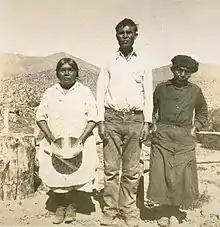 A Kawaiisu family | |
| Total population | |
|---|---|
| 2010: 60 alone and in combination[1] | |
| Regions with significant populations | |
| Languages | |
| English, Tehachapi[2] | |
| Religion | |
| traditional tribal religion, Christianity | |
| Related ethnic groups | |
| Utes and Southern Paiutes |
The Kawaiisu (pronounced: ″ka-wai-ah-soo″) are a Native Californian ethnic group in the United States who live in the Tehachapi Valley and to the north across the Tehachapi Pass in the southern Sierra Nevada, toward Lake Isabella and Walker Pass. Historically, the Kawaiisu also traveled eastward on food-gathering trips to areas in the northern Mojave Desert, to the north and northeast of the Antelope Valley, Searles Valley, as far east as the Panamint Valley, the Panamint Mountains, and the western edge of Death Valley. Today, some Kawaiisu people are enrolled in the Tule River Indian Tribe.[2]
Language
The Kawaiisu language, or Tehachapi, is a member of the Southern Numic division of the Uto-Aztecan language family.[2] The Kawaiisu homeland was bordered by speakers of non-Numic Uto-Aztecan languages. The Kitanemuk to the south spoke Takic, the Tübatulabal to the north spoke the Tübatulabal language. The Yokuts (Monilabal) to the west were non-Uto-Aztecan. Because they also spoke a Southern Numic language, the Chemehuevi to the east are the closest linguistic relatives to Kawaiisu.
The Kawaiisu have been known by several other names, including the Caliente, Paiute, Tehachapi Valley Indians, and Tehachapi Indians, but they called themselves depending on dialect Nuwu, New-wa, Nu-oo-ah or Niwiwi, meaning "The People." The tribal designations as "Kawaiisu" or "Tehachapi Indians" are both English adoptions of the Yokutsan words used by the neighboring Yokuts. Today the Kawaiisu identify themselves as "Paiute" and the self-identification term Nüwa ("People") is commonly used by themselves and in the newspapers and media.[3]
History
Before European contact, the Kawaiisu lived in permanent winter villages of 60 to 100 people. They often divided into smaller groups during the warmer months of the year and harvested California native plants in the mountains and deserts, and animals, for food and raw materials. They were divided in two regional groups: the "Desert Kawaiisu" and the "Mountain Kawaiisu".
The Kawaiisu are related by language and culture to the Southern Paiute of southwestern Nevada and the Chemehuevi of the eastern Mojave Desert of California. They may have originally lived in the desert before coming to the Tehachapi Mountains region, perhaps as early as 2000 years ago or before.
The Kawaiisu maintained friendly relations with the neighboring Kitanemuk and also participated in cooperative antelope drives (driving herds of antelope into traps so they could be more easily slaughtered) with the Yokuts, another group living in the San Joaquin Valley.
The Numic-speaking peoples of this area (Kawaiisu, Timbisha/Panamint Shoshone (Kohozi – "Koso/Panamint people"), Southern Paiute, Owens Valley Paiute (Pagazozi – "water people"), and Coso people) are famous for their petroglyphs and Rock art.[4]
In 2011, The Kawaiisu Project received the Governor’s Historic Preservation Award for its efforts to document the Kaiwaiisu language and culture, including "the Handbook of the Kawaiisu, language teaching ... the Kawaiisu Language and Cultural Center, [and] the Kawaiisu exhibit at the Tehachapi Museum."[5][6] A local newspaper noted in 2010, "There are also several hundred living Kawaiisu descendants, even though a pervasive misconception believes them to be all gone."[6][7]
Population
Estimates for the pre-contact populations of most native groups in California have varied substantially.[8] Alfred L. Kroeber proposed the combined 1770 population of the Kawaiisu as 1,500. He estimated the surviving population of the Kawaiisu in 1910 as 500.[9]
See also
- Kawaiisu traditional narratives
- Classification of indigenous peoples of the Americas
- Category:Native American history of California
Notes
- ↑ "2010 Census" (PDF). census.gov. Archived from the original (PDF) on 2014-12-09.
- 1 2 3 California Indians and Their Reservations: Kawaiisu Archived 2015-07-06 at the Wayback Machine San Diego State University Library and Information Access. Retrieved 30 June 2013.
- ↑ Sprague, Jack; Garfinkel, Alan. Handbook of the Kawaiisu – via www.academia.edu.
- ↑ "Petroglyphs.US – Rock Art Gallery – pictographs & petroglyphs". Archived from the original on 2013-05-06. Retrieved 2013-05-06.
- ↑ Jon Hammond (2011-11-29). "Kawaiisu Project receives Governor's Historic Preservation Award". TehachapiNews.com. Archived from the original on 2013-10-04. Retrieved 2012-08-26.
- 1 2 Jon Hammond (2010-04-06). "The original Tehachapi language: new grant funds new grant funds two-year Nüwa (Kawaiisu) project". TehachapiNews.com. Archived from the original on 2013-10-04. Retrieved 2012-08-26.
- ↑ "Jon Hammond: Handbook of the Kawaiisu: ground-breaking book ..." TehachapiNews.com. Archived from the original on 2013-10-05. Retrieved 2012-08-26.
- ↑ (See Population of Native California.)
- ↑ Kroeber, Alfred L (1925). Handbook of the Indians of California. Bureau of American Ethnology Bulletin. Vol. No. 78. Washington, D.C. p. 883.
{{cite book}}: CS1 maint: location missing publisher (link)
References
- Garfinkel, Alan P. (2007). "Archaeology and Rock Art of the Eastern Sierra and Great Basin Frontier". Maturango Museum Publication Number 22. Maturango Museum, Ridgecrest, California.
- Garfinkel, Alan P., Donald R. Austin, David Earle, and Harold Williams (2009). Myth, Ritual and Rock Art: Coso Decorated Animal-Humans and the Animal Master. Rock Art Research 26(2):179–197. [The Journal of the Australian Rock Art Research Association (AURA) and of the International Federation of Rock Art Organizations (IFRAO)].
- Garfinkel, Alan P. and John F. Romani (2008). Dating Aboriginal Occupation at Tihesti-va’a-di: Changing Land Use Patterns at a Kawaiisu Village, Tehachapi, California. "Kern County Archaeological Society Journal" 10:45–63.
- Garfinkel, Alan P. and Harold Williams (2011). The Handbook of the Kawaiisu: A Sourcebook and Guide to Primary Resources on the Native Peoples of the far southern Sierra Nevada, Tehachapi Mountains, and southwestern Great Basin. Wa-hi San’avi Publications.
- Gifford, Edward Winslow (1917). Tübatulabal and Kawaiisu kinship terms. Berkeley, CA: University of California Press. Retrieved 2012-08-26.